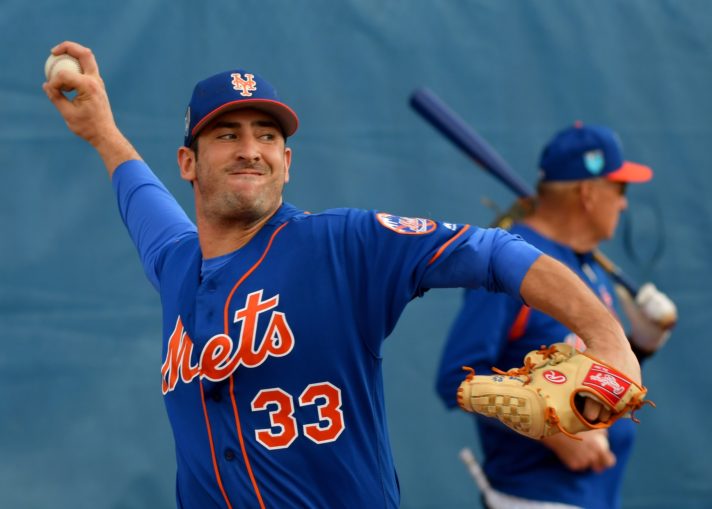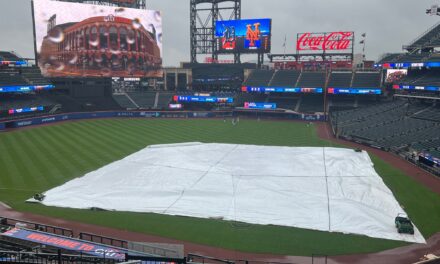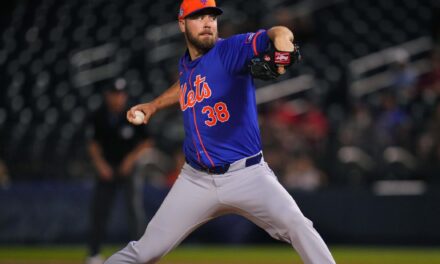
New York Mets’ starting pitcher Matt Harvey made some notable comments yesterday, as per Kevin Kernan’s article this morning for the New York Post, after an encouraging outing in which the 28-year-old struck out eight batters in five innings of work.
The fact that he allowed six hits and three earned runs is an afterthought to Harvey as he talks about his changeup, “That’s the big difference from having feel of pitches now. Being able to throw that to both righties and lefties definitely helps, especially when I can command the fastball for the most part and then use the changeup to sink it out of the zone.”
Harvey struck out five straight batters to end his outing against the Miami Marlins in the Mets 7-6 loss on Thursday. Four of the five strikeouts came swinging as the right-hander worked on his offspeed stuff.
The outing ended on a high note for Harvey, “I think that last inning was good for me to use that a bunch and was able to get a couple swings and misses with it. Today was definitely a big jump in the right direction, we’re geared up and ready to go.”
Clearly, Matt Harvey is more concerned with preparing for the season, as opposed to putting too much thought into Spring Training results.
Having a good feel for his pitches, and effective use of his secondary pitches has been the key to his success in the past. And will be an even bigger key going forward now that his fastball is mostly sitting 92-94 mph.
The six-year MLB-veteran saw his most success early on in his career, from 2012 to 2015 (minus 2014). Those seasons saw him throw his fastball 61.6% of the time, and a virtually-even combination of his slider, curve, and changeup otherwise.
His average O-Swing% (swings on pitches outside the strike zone) during that period of time was 33.5%, and his Z-Swing% (inside the zone) was 67.3%.
His swinging strike percentage over those three seasons were 12.0 in 2012, 12.6 in 2013, and 11.6 in 2015.
Though Harvey didn’t qualify for the MLB leaders in the category in 2012, the league-leader was Cole Hamels, then of the Phillies, with 13.0.
In 2013, Harvey was second in all of baseball with his 12.6, finishing just three-tenths of a percentage-point behind Yu Darvish (12.9). His 11.6 in 2015 was 16th in the league among qualified pitchers.
Clearly, when Harvey is able to use all of his pitches effectively he’s at his best. It will be interesting to see how Harvey decides to mix up his pitches this season after throwing his curveball a career-low 6.9% of the time last year while keeping with career norms with fastball usage despite it’s ineffectiveness.
Mets’ manager Mickey Callaway has had his pitching staff focusing mostly on throwing fastballs early this spring, hoping to build up their arm strength.
When asked about the effectiveness of his methods on Harvey, he had this to say, “It seems to be working, [Harvey] was up to 96 [mph] today. Because his arm speed is back, he has conviction in his pitches. And when you can sell that changeup that’s what it’s all about. He has great stuff he just needs to have the confidence that he can go out there and compete with anybody and he’s showing that.’’
Again, with Harvey healthy enough to use all of his pitches, in addition to now being able to experiment with more parts of the plate due to Dave Eiland‘s new mantra, we could see a different pitcher this season.
It’s been a rough road back from multiple, serious injuries for Matt Harvey since his domination of the National League in earlier years. Hopefully, he can adapt to using his offspeed more to become more effective than his horrendous 2017 season.















